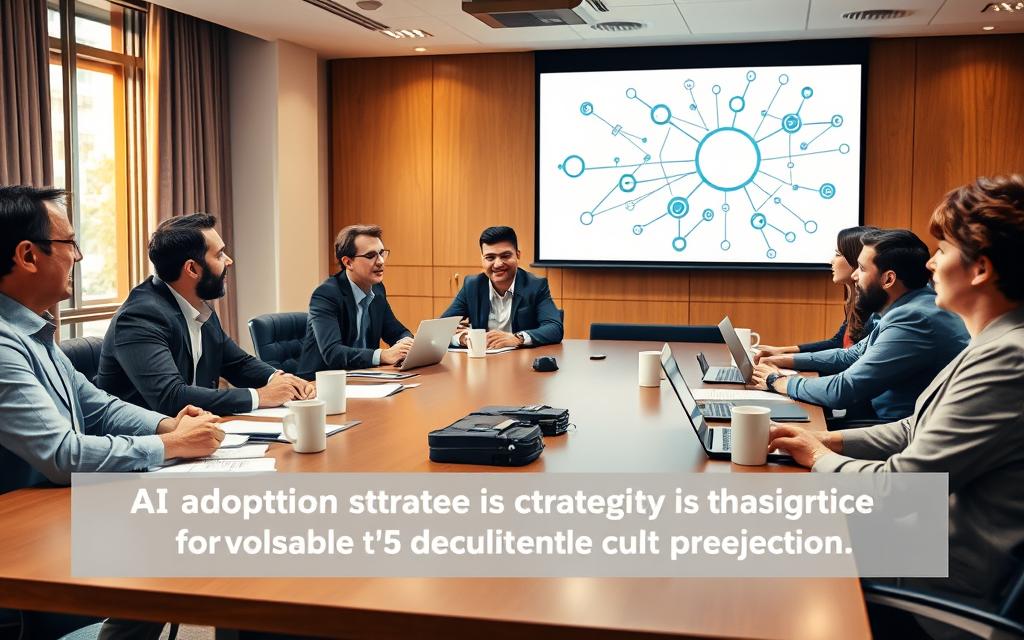Table of Contents
Artificial intelligence is transforming industries, yet many companies face roadblocks in adoption. Research shows 85% of AI projects fail to deliver ROI, often due to implementation hurdles. From integration complexity to skills gaps, these challenges hinder progress.
McKinsey reports 76% of executives cite technical barriers as a top concern. Legacy systems, data quality issues, and ethical dilemmas further complicate deployments. Without proper strategies, organizations risk wasted resources and missed opportunities.
This article explores common pain points and actionable solutions. Learn how to navigate infrastructure limitations, upskill teams, and align AI processes with business goals. Discover why some enterprises succeed while others fall behind in the race for innovation.
For deeper insights on overcoming these obstacles, review this analysis of AI implementation challenges.
Lack of In-House AI Expertise
The demand for AI specialists far exceeds supply, leaving organizations scrambling for solutions. MIT Sloan reports 68% of companies face moderate-to-extreme skills shortages. Without the right talent, projects stall or rely on expensive consultants.
The Growing Skills Gap in AI Talent
Only 22% of academic programs teach applied AI, worsening the scarcity. Business leaders grapple with delayed implementations and inflated costs. “The shortage isn’t just technical—it’s strategic,” notes Nic DeAngelo of Saint Investment.
“Start small with pilot projects. Leverage user-friendly tools like AutoML platforms, and partner with universities for fresh talent.”
Strategies to Build Internal AI Capabilities
Unilever’s AI academies trained 30,000 employees, proving scalable upskilling works. Key steps:
- Launch mentorship programs pairing external experts with staff.
- Use low-code platforms to democratize access.
- Measure progress through micro-certifications.
Hybrid hiring models blend contractors for immediate needs with long-term internal training. This balances efficiency with sustainable growth.
Uncertainty About Where to Implement AI
Many business leaders hesitate when selecting AI applications, fearing wasted resources. A PwC study reveals 41% of customers abandon brands after poor AI interactions. Misaligned use cases, like generic chatbots, erode trust instead of boosting efficiency.

Identifying High-Impact Use Cases
Brittany Hodak advises auditing workflows to pinpoint repetitive, rules-based tasks first. For example:
- Starbucks’ predictive inventory AI reduced waste by 23%.
- CNET’s error-prone AI articles damaged credibility.
Netflix’s recommendation engine drives 80% of viewer activity, proving targeted applications deliver measurable impact.
Balancing Automation with Human Oversight
The Mayo Clinic uses a “human-in-the-loop” model to validate diagnostic AI. This hybrid approach ensures accuracy while scaling efficiency. Below is a framework to prioritize high-ROI AI applications:
| Criteria | Low Priority | High Priority |
|---|---|---|
| ROI Potential | > 30% efficiency gain | |
| Data Readiness | Fragmented sources | Structured datasets |
| User Impact | Minimal customer touchpoints | High-frequency interactions |
Start with low-risk, high-reward tasks to build confidence in implementation. Gradually expand to complex processes as teams adapt.
Outdated Infrastructure and Integration Challenges
Siloed data systems prevent 63% of enterprises from scaling automation effectively (Gartner). Legacy technology lacks compatibility with modern AI models, forcing teams into manual workarounds. Real-time processing becomes impossible when integration relies on patchwork solutions.
Assessing Your Current Systems
Brian David Crane’s 5-step framework identifies technical debt:
- Audit data pipelines: Map fragmented sources and latency issues.
- Evaluate API limitations: Can legacy systems handle real-time queries?
- Score cloud readiness: AWS SageMaker reduces setup time by 40%.
- Calculate upgrade costs: Walmart’s $1.4B overhaul boosted forecasting accuracy.
- Prioritize hybrid integration for sensitive data.
Steps to Modernize for AI Readiness
Cloud-native platforms like Kubernetes accelerate implementation, but serverless options suit smaller deployments. Key actions:
- Migrate high-volume transactions first (e.g., customer service bots).
- Use middleware to bridge legacy systems during transitions.
- Partner with certified vendors for phased updates.
“Modern infrastructure isn’t optional—it’s the foundation for scalable AI. Start with low-risk modules to prove ROI.”
Data Privacy and Security Concerns
Data breaches in AI deployments cost enterprises an average of $4.45M per incident (IBM). Cognizant reveals 58% of adopters violate GDPR due to opaque data practices. Without robust protocols, sensitive information becomes a liability.

Navigating Compliance and Regulations
GDPR fines reach €20M or 4% of global revenue for non-compliance. Key pitfalls:
- Training data misuse: IBM’s $2.3M fine stemmed from biased hiring algorithms.
- Inadequate anonymization: CCPA mandates deletion of personal data upon request.
Blair Thomas of eMerchantBroker advises: “SOC 2-certified vendors reduce exposure. Encrypt datasets end-to-end, even during LLM training.”
Best Practices for Secure AI Deployment
Microsoft’s Confidential Computing framework isolates healthcare data during processing. Follow this checklist:
- Apply differential privacy to mask identities in datasets.
- Audit third-party tools for ISO 27001 certification.
- Limit access with role-based controls.
“Assume every dataset is a target. Encryption isn’t optional—it’s your first defense.”
Ethical and Legal Risks of AI Adoption
Ethical dilemmas in AI deployment often overshadow its transformative potential. From biased algorithms to murky intellectual property laws, these challenges demand proactive strategies. A Reuters investigation revealed Amazon’s recruiting tool favored male candidates by 40%, exposing systemic flaws in machine learning models.

Addressing Algorithmic Bias
Bias in mortgage approval systems disproportionately denies minority applicants. Tools like IBM’s AI Fairness 360 analyze datasets for disparities. Key steps to mitigate risks:
- Audit training data for historical biases.
- Implement continuous monitoring for models in production.
- Adopt the EU AI Act’s risk tiers for liability management.
Managing Intellectual Property Challenges
Renato Agrella’s research shows 23% of AI-generated patents face ownership disputes. The World Intellectual Property Organization (WIPO) urges clear frameworks for co-authored inventions. Consider this comparison of IP protection tools:
| Tool | Use Case | Compliance |
|---|---|---|
| Google’s Ethics Review | AI-generated content | Aligns with GDPR |
| IBM Patent Server | Inventor attribution | U.S. patent law |
| EU AI Act Template | High-risk applications | EU-wide standards |
“IP disputes will surge as AI invents autonomously. Document every stage of development to prove human oversight.”
Balancing innovation with ethics requires cross-functional teams. Google’s AI ethics board template offers a blueprint for governance. Prioritize transparency to build trust in evolving regulations.
Overcoming Resistance to AI Adoption
Resistance to AI adoption remains a critical barrier for organizations aiming to harness its full potential. Gallup reveals 67% of employees fear job displacement, while customers distrust opaque processes. Addressing these concerns requires transparency and tangible benefits.

Gaining Employee and Customer Trust
Abhijeet Kaldate’s transparency playbook recommends quarterly AI impact reports. Salesforce boosted adoption by 200% through “AI Day” workshops, demystifying tools for staff.
The Mayo Clinic’s patient communication strategy includes:
- Explaining diagnostic AI’s role in supporting (not replacing) doctors.
- Showcasing efficiency gains like faster test results.
UPS reduced driver turnover by 15% using AI-optimized routes. This improved work-life balance, proving automation can enhance tasks without eliminating jobs.
Demonstrating AI’s Complementary Role
BMW’s reskilling programs contrast Blue Apron’s layoffs, highlighting two approaches. Phased rollouts balance automation with human-centric design:
- Start with repetitive tasks (e.g., data entry).
- Use AI insights to augment decision-making.
- Scale only after proving ROI in pilot processes.
“Resistance fades when teams see AI as a collaborator. Highlight its role in eliminating drudgery, not people.”
Conclusion: Turning AI Challenges into Opportunities
Forward-thinking companies that address expertise gaps and modernize infrastructure unlock scalable solutions. Early adopters achieve 19% higher profitability, proving strategic investments pay off.
Jacob Kinsey’s research highlights a $15.7T global GDP potential by 2030. His ROI formula shows $3.50 in risk savings for every $1 spent on ethical frameworks. This balance drives sustainable growth.
Collaborative learning accelerates success. Joining groups like Partnership on AI helps business leaders navigate evolving standards. Industry-specific advances, from precision medicine to smart logistics, redefine competitive edges.
Start with pilot projects to test viability. Assess readiness using tools like this AI maturity framework. The future belongs to those who transform obstacles into innovation springboards.
FAQ
What are the biggest challenges companies face with AI adoption?
The top obstacles include a shortage of skilled talent, unclear use cases, outdated systems, data security risks, and ethical concerns. Leaders must prioritize training, infrastructure upgrades, and compliance.
How can organizations identify the best AI applications?
Focus on high-impact areas like customer service automation, predictive analytics, or fraud detection. Pilot projects with measurable ROI help validate effectiveness before scaling.
What steps improve AI integration with legacy systems?
Start with API-friendly tools like Microsoft Azure AI or IBM Watson. Conduct compatibility audits, then phase in cloud-based solutions for smoother machine learning model deployment.
How do regulations impact AI implementation?
GDPR, CCPA, and industry-specific rules require transparent data usage. Work with legal teams to ensure algorithms meet privacy standards while maintaining efficiency.
Can small businesses benefit from AI without major investments?
Yes. Platforms like Zoho CRM with built-in AI or Google’s AutoML offer affordable entry points. Many providers now offer scalable subscription models.
What metrics prove AI’s business value?
Track time savings on repetitive tasks, error reduction rates, customer satisfaction scores, and revenue growth from personalized recommendations.
How should companies address employee concerns about AI?
Highlight AI as a productivity tool—not a replacement. Offer upskilling programs and involve teams in selecting automation tools that enhance their workflows.









